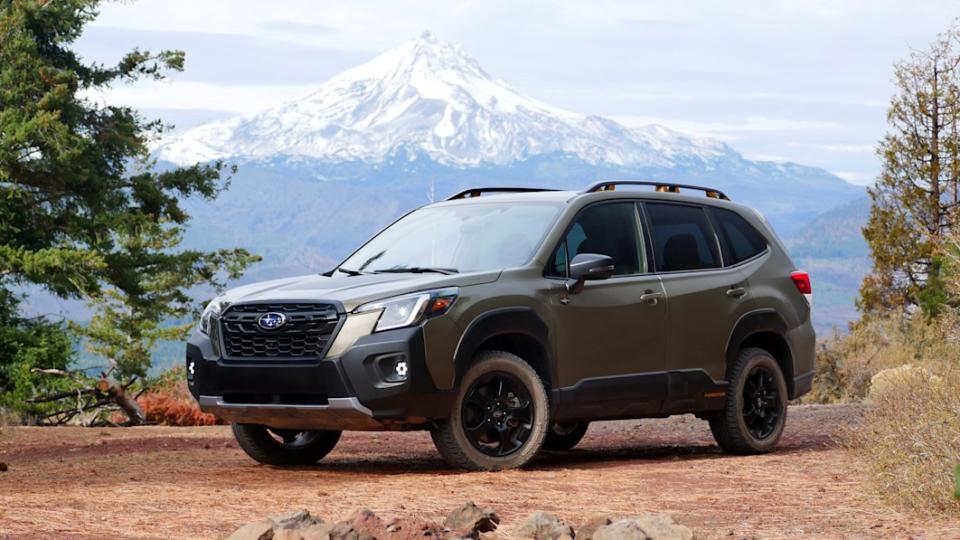2022 Subaru Forester Wilderness First Drive Review | Take a hike

POWEL BUTTE, Ore. — "It's about the journey, not the destination." This has long been a rallying cry for enthusiasts everywhere who see cars as more than simply the means of traveling from point A to B. It's particularly apt for off-roading enthusiasts. For them, of course, it's about the journey – there will almost certainly be a better way of getting from here to there than at 5 mph up a boulder-strewn hill.
The 2022 Subaru Forester Wilderness is not that type of off-roader. It ultimately makes the journey easier, more comfortable and less nerve-wracking, but its owner is almost certainly more concerned with the destination. Specifically the camping spot, the hiking trail, the alpine lake, etc. And this isn't some marketing strawman or a dream scenario for owners who'll really only ever take it to Whole Foods.
People really are going outside more. According to data from Statista and provided by Subaru, about 17 million more people hiked in 2019 than they did 10 years prior, and it's hard to imagine those numbers not going up in the past two years. Furthermore, the number of people camping had already been increasing before the pandemic, and data from 2020 show that 21% of campers did so for the first time.
And it probably won't surprise you that among people who frequent the great outdoors, the Subaru Forester is one of the top choices. Subaru says 36% of Forester owners use their vehicles to carry outdoor equipment, which is tops in the industry, and nearly 25% of them go camping – only the Jeep Cherokee is higher, and barely so. The segment average is around 17%. And for those compact SUV shoppers who actually go off-road, the Forester is again second only to the Cherokee, with about 17% of owners, or double the segment average.
The new Forester Wilderness would be Subaru doubling down on these trends and the brand's existing success. The Forester already has more ground clearance at 8.7 inches than everything in the segment other the Jeep Cherokee Trailhawk, which matches it (the other versions have less). The Wilderness raises the floor by a half-inch, going up to 9.2 inches by adjusting the actual coil spring and damper lengths (as opposed to the spacers typically used in aftermarket lifts). Now, this isn't quite as high as the 9.5 inches boasted by the Subaru Outback Wilderness, but the Forester was limited by production issues – basically, if it got any higher, it would run into some piece of equipment in the factory.
The Forester has an advantage in terms of other clearances, however. The approach angle goes up to 23.5 degrees (the base Forester and Outback Wilderness are 20), while the departure angle goes up to 25.4 degrees (the base Forester is at 24.6, the Outback Wilderness at 23.6). The breakover goes up to 21 degrees from 19.6, and falls just 0.2 degree short of the Outback. All of the above trail the Cherokee Trailhawk considerably, but better every other version of Jeep's compact SUV.
The approach and departure angles relative to the Outback speak to its shorter overhangs, but there's more to the gains than simply the suspension height increase. The lower front fascia was reshaped specially for the Wilderness to come up slightly in the front and at the corners. There's also an aluminum skid plate, should that approach angle not be wide enough. Other visual differences include extended frontend bumper cladding, a unique grille with the Wilderness-exclusive forward camera, hexagonal fog lights, larger fender flares, a textured black trim piece and body-colored roof spoiler at the rear, and signature gold trim pieces that pair with blacked-out lettering and Wilderness badges.


There are also the 17-inch black alloy wheels wrapped in Yokohama Geolander all-terrain tires, which we're pleased to report pair far better in the Forester than they do in the Outback. In the latter, they conspire to create a squishy, delayed response off center that's almost indicative of a JK Wrangler. It doesn't exactly breed a lot of confidence on-road. Thankfully, there was no such delay detected in the Forester, and although steering response is hardly any Forester's forte on-road, the Wilderness at least provides the drivability that Subaru says its customers expect from their SUVs (as opposed to traditional off-road enthusiasts who are willing to make sacrifices on pavement for extreme capability in the dirt). Subaru also says that despite the added height, the suspension tuning actually produces less body roll than the standard Forester, which is believable since it didn't heave itself over into corners as the Outback does.
On-road comfort with the all-terrain tires does diminish slightly, but it's akin to wearing harder-sole trail running shoes on pavement. It's ultimately not that big of a deal. You feel the road a bit more, but the suspension is tuned as such that comfort is still very much maintained. More notable, however, is the Forester Wilderness suspension's behavior off-pavement. We test drove it on dirt roads more than paved ones here in Central Oregon and came away wildly impressed with the suspension's ability to sop up big and little bumps alike. Potholes that seemed likely to send sharp impacts into our spine were simply gobbled up by those long springs, the longer dampening compression stroke and the tires' ample sidewall. We were not driving slowly, and the Forester gave us little reason to slow down, it was so adept at keeping us comfortable and ably responding to our steering inputs while slaloming around larger rocks and holes. It was quite fun, actually.

 Yahoo Autos
Yahoo Autos 
